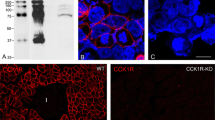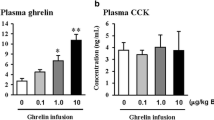Abstract
An increased ratio between serum levels of immunoreactive anionic and cationic trypsin is a common finding in many forms of pancreatic disease. Experimental studies have shown that increased stimulation with cholecystokinin (CCK) leads to an increase in the ratio between the pancreatic content of anionic and cationic trypsin. To study whether this effect is caused by increased pancreatic synthesis of anionic trypsin in relation to cationic trypsin we studied the levels of mRNA for anionic and cationic trypsinogen in pancreatic extracts from rats exposed to increased CCK levels through chronic subcutaneous administration of CCK. Northern blot and slot blot hybridization techniques were used. The ratio between mRNAs for anionic and cationic trypsin was significantly higher in CCK-treated rats: median level, 2.04 (range, 1.33–4.08) versus a median level of 1.15 (range, 0.97–2.17) in the control group;P<0.01. These findings support the view that chronic CCK stimulation leads to the increased synthesis of anionic trypsinogen compared to cationic trypsinogen.
Similar content being viewed by others
References
Rinderknecht H, Renner IG, Carmack C. Trypsinogen variants in pancreatic juice of healthy volunteers, chronic alcoholics and patients with pancreatitis and cancer of the pancreas. Gut 1979;20:886–891.
Kimland M, Russick C, Marks WH, et al. Immunoreactive aionic and cationic trypsin in human serum. Clin Chim Acta 1989;184: 31–46.
Borgström A, Marks WH, Dafoe DC, et al. Immunoreactive anionic and cationic trypsins in serum after experimental porcine pancreatic transplantation. Surgery 1986;100:841–850.
Marks WH, Borgström A, Sollinger H, et al. Serum immunoreactive anodal trypsinogen and urinary amylase as biochemical markers for rejection of clinical whole-organ pancreas allografts having exocrine drainage into the urinary bladder. Transplantation 1990;49:112–115.
Borgström A, Andrén-Sandberg Å. Elevated serum levels of immunoreactive anionic but not cationic trypsin signal pancreatic disease. Int J Pancreatology 1995;12:221–225.
Borgström A, Axelson J, Ihse I, et al. The ratio between anionic and cationic trypsin in the rat pancreas varies with CCK stimulation. Pancreas 1995;1:179–184.
Ohlsson B, Axelson J, Sternby B, et al. Time-course of the pancreatic changes following long-term stimulation or inhibition of the CCK-A receptor. Int J Pancreatol 1995;18:59–66.
Chomczynski P, Sacchi N. Single-step method of RNA isolation by acid guanidinium thiocyanate-phenol-chloroform extraction. Anal Biochem 1987;162:156–159.
MacDonald RJ, Stray SJ, Swift GH. Two similar but nonallelic rat pancreatic trypsinogens. J Biol Chem 1982;257:9724–9732.
Fletcher TS, Alhadeff M, Craik CS, et al. Isolation and characterisation of a cDNA encoding rat cationic trypsinogen. Biochemistry 1987;26:3081–3086.
Sambrook J, Fritsch EF, Maniatis T. Molecular cloning: A laboratory manual, 2nd ed. Cold Spring Harbour NY: Cold Spring Harbour Laboratory, 1989.
Guy O, Lombardo D, Bartelt DC, et al. Two human trypsinogens. Purification, molecular properties and N-terminal sequences. Biochemistry 1978;17:1669–1675.
Emi M, Nakamura Y, Ogawa M, et al. Cloning, characterisation and nucleotide sequences of two cDNAs encoding human pancreatic trypsinogens. Gene 1986;41:305–310.
Schick J, Kern H, Scheele G. Hormonal stimulation in the exocrine pancreas results in coordinate and anticoodinate regulation of protein synthesis. J Cell Biol 1984;99:1569–1574.
Author information
Authors and Affiliations
Rights and permissions
About this article
Cite this article
Borgström, A., He, X. & Axelson, J. Stimulation with cholecystokinin leads to increased ratio between mRNA levels for anionic and cationic trypsinogen in rat pancreas. J Gastroenterol 32, 797–800 (1997). https://doi.org/10.1007/BF02936957
Received:
Accepted:
Issue Date:
DOI: https://doi.org/10.1007/BF02936957




